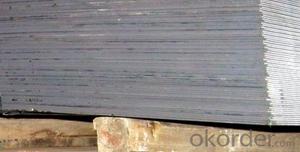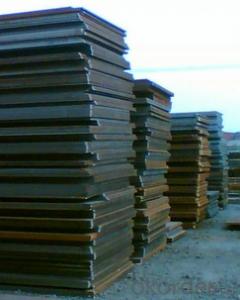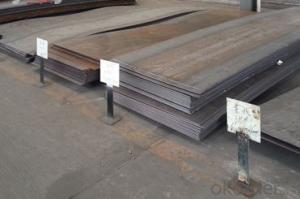Hot Rolled Carbon Steel Plate,Carbon Steel Sheet Q235d, CNBM
- Loading Port:
- Qingdao
- Payment Terms:
- TT OR LC
- Min Order Qty:
- 10 pc
- Supply Capability:
- 30 pc/month
OKorder Service Pledge
OKorder Financial Service
You Might Also Like
Quick Details
| Standard: | AISI, ASTM, GB, JIS | Grade: | Q195,Q235,Q345,A36,C45 | Thickness: | 1.0-30MM |
| Model Number: | Q235,Q195,Q345 | ||||
| Type: | Steel Plate | Technique: | Hot Rolled | Surface Treatment: | Coated |
| Application: | Ship Plate | Special Use: | Silicon Steel | Width: | 30-2000mm |
| Length: | as your requirement | standard: | hot rolled | Surface: | Anti-rust oil |
Packaging & Delivery
| Packaging Details: | seaworthy packages or as customers' require |
| Delivery Detail: | within 15 days after the advance payment |
Hot rolled steel plate
1 carbon steel plate 3mm thick General information
| Product name | Type | Specification | Implementation of GB | ||
| thick | wide | long | |||
| Carbon structural steel | Q195,Q215, Q235A,Q235B, Q235C,Q255, Q275 | 4-120 | 1500-4500 | 6000-12000 | GB/T700-2006 |
| Low-alloy structural steel | Q295,Q345A, Q345B,Q2345C | 4-120 | 1500-4500 | 6000-12000 | BG/T1591-1994 |
| Quality carbon structural stee | 30-50 | 4-120 | 1500-4500 | 6000-12000 | BG/T699-1999 |
| Ship steel | CCSA,CCSB | 4-120 | 1500-4500 | 6000-12000 | materials and welding condition |
| CCSAH32,CCSAH36 CCSDH32,CCSDH36 | 4-120 | 1500-4500 | 6000-12000 | materials and welding condition or GB 712-2000 | |
| Boiler steel | 20g,22Mng, 16Mng,19Mng | 4-120 | 1500-4500 | 6000-12000 | GB 713-1997 |
| Pressure vessel steel | 1622Mng,20R, 15MnVR,15MnVNR | 4-120 | 1500-2700 | 6000-12000 | GB 6654-1996 |
| European standard plate
| S235JR,S235J0, S275JR,S275J0, S275JR2,S355JR, S355J0,S355J2 | 4-120 | 1500-4500 | 6000-12000 | EN 10025 |
| Japanese standard plate | SS400,SS400-B | 4-120 | 1500-4500 | 6000-12000 | JIS G3101-2004 |
2 carbon steel plate 3mm thick detail specification
Material:
A283Gr.D/A573Gr.65,A516Gr65,A516Gr70,A284Gr.D
SS400,SS300,CCSB A36,A32,LRA32,LRB,Q235
Q195,Q235,Q345,SS400,ASTM A36,E235B
Thickness: 4mm-120mm
width: 1500mm-4500mm
Length:2-10m ,accordingly
Thickness | 4-120mm |
Width | 1500-4500mm or as custom's request |
Length | 2-12m,as your requirment |
Technique | Cold rolled or hot rolled |
Surface treatment | Bare, galvanized coated or as customer's requirements. |
Standard | ASTM,EN,GB,JIS,GB |
Material | A283Gr.D/A573Gr.65,A516Gr65,A516Gr70,A284Gr.D SS400,SS300,CCSB A36,A32,LRA32,LRB,Q235 Q195,Q235,Q345,SS400,ASTM A36,E235B |
Terms of Payment | L/C or T/T |
Chemical composition | C≤0.004%;Si≤0.030%; Mn ≤0.17%;P≤0.012%; S≤0.010%; Fe balance |
Delivery Detail | within 30days once receive deposite or confirm L/C |
Packing | Standard export packing,or as requirement |
3 carbon steel plate 3mm thick application:
construction,machinery manufacturing, container manufacturing, shipbuilding, bridge construction. Can also be used to manufacture a variety of containers, the furnace shell, furnace plate, bridge and vehicle static steel plate, low alloy steel plate,shipbuilding plate, boiler plate, pressure vessel plate, pattern plate, tractor parts, automobile frame steel plate and welding components
- Q:Can the steel sheets be bent without cracking?
- Yes, steel sheets can be bent without cracking. The ability of steel sheets to be bent without cracking depends on a few factors such as the type and grade of steel, the thickness of the sheet, and the bending process used. Generally, steel sheets can be successfully bent without cracking as long as the bending radius and angle are within the recommended limits for that specific type and grade of steel. Additionally, preheating the steel sheet before bending can also help reduce the risk of cracking. It is important to follow proper bending techniques and use appropriate tools to ensure successful and crack-free bending of steel sheets.
- Q:Can steel sheets be used in construction projects?
- Yes, steel sheets can definitely be used in construction projects. They are commonly used for various applications such as roofing, walls, flooring, and structural framework due to their strength, durability, and versatility. Steel sheets offer excellent load-bearing capacity, fire resistance, and resistance to environmental factors, making them a popular choice in both residential and commercial construction projects.
- Q:Are steel sheets resistant to chemical exposure?
- Yes, steel sheets are generally resistant to chemical exposure.
- Q:What are the different types of steel sheet patterns?
- There are several different types of steel sheet patterns commonly used in various industries. Some of the most popular ones include: 1. Plain Steel Sheet: This is the most basic and simple type of steel sheet pattern. It is smooth and does not have any visible texture or pattern. 2. Diamond Pattern Steel Sheet: This type of steel sheet has a diamond-shaped pattern embossed or raised on its surface. It is commonly used for walkways, stair treads, and other applications where slip resistance is important. 3. Perforated Steel Sheet: Perforated steel sheets are made by punching holes in the sheet to create a pattern of openings. These sheets are commonly used for ventilation, filtration, and decorative purposes. 4. Corrugated Steel Sheet: Corrugated steel sheets have a series of parallel ridges and grooves, giving them a wavy appearance. This pattern provides added strength and rigidity, making them suitable for roofing and siding applications. 5. Checkered Steel Sheet: Checkered steel sheets have a pattern of raised squares or rectangles on their surface, similar to a chessboard. They are commonly used for flooring, stairs, and decorative purposes. 6. Hammered Steel Sheet: Hammered steel sheets have a unique texture created by hammering the surface, giving them a rough, rustic appearance. They are often used for decorative purposes and can add a distinct visual appeal to various applications. 7. Brushed Steel Sheet: Brushed steel sheets have a brushed or satin-like finish, achieved by rubbing the surface with an abrasive material. This pattern gives the sheet a smooth, uniform appearance and is commonly used for architectural and decorative applications. These are just a few examples of the different types of steel sheet patterns available. Each pattern has its own unique characteristics and applications, allowing for a wide range of uses in various industries.
- Q:What are the common sizes of steel sheets available?
- To meet the diverse needs of different industries and applications, a variety of sizes of steel sheets are available. The sizes of steel sheets can vary depending on the manufacturer and the specific requirements of the customer. However, there are standard sizes widely available in the market. The most popular sizes of steel sheets are as follows: 1. 4 feet by 8 feet: This size is widely used in construction, manufacturing, and automotive industries. It is suitable for various applications like roofing, siding, and fabrication due to its large surface area. 2. 4 feet by 10 feet: Similar to the 4 feet by 8 feet sheets, this size provides a larger surface area. It is ideal for bigger projects that require more material. 3. 5 feet by 10 feet: With an even larger surface area than the 4 feet by 10 feet sheets, this size is perfect for industrial applications that need extensive coverage. 4. 6 feet by 12 feet: This larger size is commonly used in heavy-duty applications such as shipbuilding, construction of large structures, and industrial machinery. It's important to acknowledge that these are just some of the common sizes available. Manufacturers offer many other sizes to meet specific requirements. Moreover, steel sheets can be custom-cut to fit specific dimensions, allowing for greater flexibility and tailoring to individual project needs.
- Q:What is the difference between zinc-coated and zinc-aluminum coated steel sheets?
- Zinc-coated steel sheets are made by applying a layer of pure zinc onto the surface of the steel through a process called galvanization. On the other hand, zinc-aluminum coated steel sheets are created by combining zinc and aluminum in a specific ratio before applying it to the steel surface. The addition of aluminum enhances the corrosion resistance and durability of the coating compared to pure zinc-coated sheets.
- Q:What are the different sizes of steel sheets available?
- Steel sheets are available in a wide range of sizes, catering to various applications and industries. The sizes of steel sheets can vary depending on factors such as thickness, width, and length. In terms of thickness, steel sheets are commonly available in gauges ranging from 7 to 30. The higher the gauge number, the thinner the sheet. Thinner sheets, such as those with a gauge of 30, are often used for applications that require flexibility, while thicker sheets, such as those with a gauge of 7, are typically used for heavy-duty applications that require high strength and durability. When it comes to width, steel sheets are available in a range of options. The most common widths include 36 inches, 48 inches, and 60 inches. However, customized widths can be obtained for specific requirements. Regarding length, steel sheets are typically available in standard lengths of 96 inches and 120 inches. These lengths are commonly used in various industries. However, like width, the length can also be customized to fit specific needs. It is important to note that the availability of different sizes of steel sheets may vary depending on the supplier and the specific grade of steel being used. It is advisable to consult with a steel sheet supplier or manufacturer to determine the exact sizes available for a particular application.
- Q:Are steel sheets resistant to rust or corrosion?
- Yes, steel sheets are resistant to rust and corrosion.
- Q:How do steel sheets perform in terms of scratch resistance?
- Renowned for their exceptional ability to resist scratches, steel sheets are widely recognized for their strong and durable nature. This quality makes them highly suitable for a multitude of applications where they may come into contact with objects or surfaces that could potentially cause damage. Moreover, steel sheets possess the capacity to endure regular wear and tear, rendering them particularly suitable for demanding environments with heavy usage. Furthermore, the scratch resistance of steel sheets can be further enhanced by applying coatings or finishes, thereby achieving an even higher level of protection. In summary, the outstanding scratch resistance of steel sheets has earned them a well-deserved reputation as a reliable choice for a diverse range of industrial and commercial purposes.
- Q:Can steel sheets be used in the construction of bridges?
- Yes, steel sheets can be used in the construction of bridges. Steel sheets are commonly used as structural components for various types of bridges due to their high strength, durability, and resistance to corrosion. They provide excellent load-bearing capacity and can be easily fabricated and assembled, making them a popular choice in modern bridge construction.
1. Manufacturer Overview |
|
|---|---|
| Location | |
| Year Established | |
| Annual Output Value | |
| Main Markets | |
| Company Certifications | |
2. Manufacturer Certificates |
|
|---|---|
| a) Certification Name | |
| Range | |
| Reference | |
| Validity Period | |
3. Manufacturer Capability |
|
|---|---|
| a)Trade Capacity | |
| Nearest Port | |
| Export Percentage | |
| No.of Employees in Trade Department | |
| Language Spoken: | |
| b)Factory Information | |
| Factory Size: | |
| No. of Production Lines | |
| Contract Manufacturing | |
| Product Price Range | |
Send your message to us
Hot Rolled Carbon Steel Plate,Carbon Steel Sheet Q235d, CNBM
- Loading Port:
- Qingdao
- Payment Terms:
- TT OR LC
- Min Order Qty:
- 10 pc
- Supply Capability:
- 30 pc/month
OKorder Service Pledge
OKorder Financial Service
Similar products
New products
Hot products
Related keywords






























